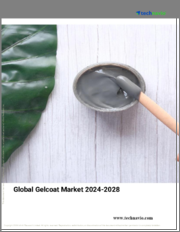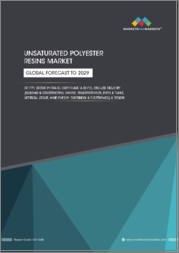
|
시장보고서
상품코드
1618459
세계의 겔코트 시장 규모 : 수지 유형별, 최종 용도 산업별, 도포 방법별, 지역별, 범위 및 예측Global Gelcoat Market Size By Resin Type, By End-Use Industry, By Application Method, By Geographic Scope And Forecast |
||||||
겔코트 시장 규모와 예측
겔코트 시장 규모는 2023년에 13억 5,000만 달러로 평가되며, 2030년에는 21억 4,000만 달러에 달할 것으로 예측되며, 예측
기간인 2024-2030년에는 CAGR 8%로 성장할 것으로 예측됩니다.
세계의 겔코트 시장 성장 촉진요인
겔코트 시장 시장 성장 촉진요인은 다양한 요인에 의해 영향을 받을 수 있습니다.
복합소재 산업의 성장
겔코트는 복합재료, 특히 유리섬유 강화 폴리머(FRP)의 제조에 있으며, 외부 보호층으로 자주 채택되고 있습니다. 풍력에너지, 해양, 자동차, 건설, 항공우주 및 기타 분야에서 복합재료 산업의 확대로 인해 겔코트에 대한 수요가 증가하고 있습니다.
성장하고 있는 해양 분야
겔코트는 매끄럽고 탄력적이며 내후성이 우수한 표면을 제공할 수 있으므로 해양 분야에서 선체, 갑판 및 기타 부품에 자주 사용됩니다. 요트 건조, 레저용 보트 및 상업용 선박 증가로 인한 해양 산업의 확대로 인해 겔코트에 대한 수요가 증가하고 있습니다.
인프라 및 건설 분야에서 수요 증가
겔코트는 인프라 및 건설 산업에서 위생 설비, 장식용 패널, 건축적 특징에 사용됩니다. 겔코트 제조업체는 도시화, 인프라 개발 및 리노베이션 프로젝트에 힘입어 건설 산업의 부상으로 이익을 얻을 수 있습니다.
자동차 산업의 성장 :
겔코트는 차체 패널, 스포일러, 내장재 등 자동차 부품의 외관, 강인성, 내후성을 향상시키기 위해 사용됩니다. 자동차 생산량 증가, 경량 소재에 대한 요구, 개인화 추세에 따른 자동차 산업의 확대로 인해 겔코트는 높은 수요를 보이고 있습니다.
신재생에너지 인프라 개발:
풍력 터빈 블레이드 및 기타 재생 에너지 구조물 부품은 겔코트를 사용하여 제조됩니다. 풍력에너지 산업에서 겔코트 수요는 이산화탄소 배출량을 줄이고 화석 연료를 절약하려는 노력에 의해 추진되는 재생에너지 인프라의 개발로 인해 촉진되고 있습니다.
부식 방지 재료에 대한 수요 증가:
겔코트는 자외선 안정성과 내식성이 뛰어나 해양 구조물, 화학 처리 및 해양 용도와 같이 연마성이 높은 상황에서 사용하기에 이상적입니다. 보호 도료로서 겔코트 수요는 다양한 산업 분야에서 내식성 제품의 필요성에 의해 촉진되고 있습니다.
겔코트 제형의 발전
저휘발성 유기화합물(VOC) 처방, 환경 친화적 선택, 성능 향상을 위한 특수 첨가제 등 지속적인 처방 개선으로 겔코트의 적용 범위와 매력은 다양한 분야에서 확대되고 있습니다.
장식적이고 견고한 표면에 대한 소비자 선호도:
겔코트는 매끄럽고 광택이 나며 내구성이 뛰어난 표면을 제공하므로 주방 조리대, 레저용 차량(RV), 수상 오토바이와 같은 소비재에 널리 사용되고 있습니다. 다양한 용도의 겔코트 시장은 오래 지속되는 제품과 미적 매력을 추구하는 소비자 수요에 힘입어 성장하고 있습니다.
노후화된 인프라 개보수 및 유지관리:
주차장, 교량, 하수처리장 등 노후화된 인프라의 수명을 늘리고 수명을 연장하기 위해 겔코트가 채택되고 있습니다. 보호 코팅으로서의 겔코트 수요는 인프라 개조 프로젝트에 의해 증가하고 있습니다.
세계 겔코트 시장
억제요인
겔코트 시장을 억제하는 몇 가지 요인과 과제가 있습니다. 여기에는 다음과 같은 것이 포함됩니다.
최종 사용 산업에 대한 의존도 :
최종 사용 산업 의존도: 해운, 자동차, 건설, 풍력에너지 부문은 겔코트에 대한 수요가 높은 최종 사용 산업 중 하나입니다. 경기 침체나 특정 산업의 변동으로 인해 겔코트 제품에 대한 수요가 감소할 수 있으며, 이는 시장 확대에 장애가 될 수 있습니다.
원재료 가격 변동:
겔코트 생산은 안료, 첨가제, 충진제, 수지 등 원료에 따라 달라집니다. 이러한 원재료의 가격은 변동될 수 있으며, 이는 가격 전략과 겔코트 제조업체의 수익성에 영향을 미칠 수 있습니다. 이러한 변동은 수요 및 공급의 움직임, 환율 변동, 지정학적 사건 등 다양한 원인으로 인해 발생할 수 있습니다.
지속가능성 및 환경 규제에 대한 관심사:
겔코트 조성물에는 휘발성 유기화합물(VOC) 및 기타 대기 및 수질 오염을 유발할 수 있는 잠재적으로 위험한 물질이 함유되어 있을 수 있습니다. 규제 당국의 감시가 강화되고 환경 문제에 대한 소비자의 지식이 높아짐에 따라 규제가 강화되고 저 VOC, 친환경 겔코트 대체품에 대한 요구가 증가할 수 있습니다.
겔코트는 페인트, 분말 코팅, 필름 라미네이션과 같은 대체 코팅 기술과의 경쟁에 직면해 있습니다. 이러한 대체품은 더 저렴한 비용, 더 빠른 도포 시간, 특정 용도에서 더 나은 성능 등의 이점을 제공함으로써 겔코트 사업을 위협할 수 있습니다.
긴 교체 주기:
겔코트는 운송 및 해양과 같이 제품 교체 주기가 긴 산업에서 표면 마감 및 보호에 자주 사용됩니다. 새로운 겔코트 제품에 대한 수요는 확장이나 혁신보다는 교체에 의해 발생하므로 교체 주기가 길면 시장 성장이 둔화될 수 있습니다.
유통기한 및 보관 조건의 제한:
품질과 기능을 유지하기 위해 겔코트 제품은 특정 상황에서 보관해야 합니다. 유통 기한이 제한되어 있습니다. 제조업체와 유통업체는 낭비를 줄이고 수익성에 악영향을 미치는 제품 부패를 방지하기 위해 재고를 올바르게 관리해야 합니다.
복잡한 도포 공정 및 기술 요구 사항:
겔코트 도포는 정확한 표면 처리, 혼합 및 도포를 보장하기 위해 전문 장비와 숙련된 인력이 필요합니다. 분야와 용도에 따라서는 도포 절차의 복잡성이나 숙련된 작업자의 필요성으로 인해 겔코트의 사용이 제한될 수 있습니다.
세계 경제의 불확실성 :
겔코트 분야에서는 무역 분쟁, 지정학적 분쟁, 경제 불확실성으로 인해 공급망이 혼란스러워지고 시장이 불안정해질 수 있습니다. 겔코트 제품 수요는 불투명한 경제 상황으로 인한 소비자와 기업의 신중한 지출에 영향을 받을 수 있습니다.
목차
제1장 서론
- 시장의 정의
- 시장 세분화
- 조사 방법
제2장 개요
- 주요 조사 결과
- 시장 개요
- 시장 하이라이트
제3장 시장 개요
- 시장 규모와 성장 가능성
- 시장 동향
- 시장 성장 촉진요인
- 시장 성장 억제요인
- 시장 기회
- Porter's Five Forces 분석
제4장 겔코트 시장 : 수지 유형별
- 폴리에스테르계 겔코트
- 에폭시 겔코트
- 비닐에스테르계 겔코트
- 기타
제5장 겔코트 시장 : 용도 산업별
- 해양
- 운송
- 건설
- 풍력에너지
- 산업
- 기타
제6장 겔코트 시장 : 도포 방법별
- 스프레이 도포
- 브러시/롤러 도포
- 몰드 인 도포
- 겔코트 보수
제7장 지역 분석
- 북미
- 미국
- 캐나다
- 멕시코
- 유럽
- 영국
- 독일
- 프랑스
- 이탈리아
- 아시아태평양
- 중국
- 일본
- 인도
- 호주
- 라틴아메리카
- 브라질
- 아르헨티나
- 칠레
- 중동 및 아프리카
- 남아프리카공화국
- 사우디아라비아
- 아랍에미리트
제8장 시장 역학
- 시장 성장 촉진요인
- 시장 성장 억제요인
- 시장 기회
- 시장에 대한 COVID-19의 영향
제9장 경쟁 구도
- 주요 기업
- 시장 점유율 분석
제10장 기업 개요
- Ineos
- Interplastic Corporation
- Allnex GMBH
- Polynt S.p.A.
- BUFA Composite Systems GmbH & Co. KG
- HK Research Corporation
- Scott Bader Company
- Alpha Owens-Corning(AOC) Aliancys
- Polynt-Reichhold Group
- Turkuaz Polyester
- Resoltech
- Soromap Group
- Gurit
- Sea Hawk Paints
- Fiberglass Coatings Inc.
제11장 시장 전망과 기회
- 신규 기술
- 향후 시장 동향
- 투자 기회
제12장 부록
- 약어 리스트
- 전시와 참고 문헌
Gelcoat Market Size And Forecast
Gelcoat Market size was valued at USD 1.35 Billion in 2023 and is projected to reach USD 2.14 Billion by 2030 , growing at a CAGR of 8% during the forecast period 2024-2030.
Global Gelcoat Market Drivers
The market drivers for the Gelcoat Market can be influenced by various factors. These may include: Growth in the Composites Industry: Gelcoat is frequently employed as an exterior layer of protection in the production of composite materials, especially fiberglass reinforced polymers (FRP). The need for gelcoat is driven by the expansion of the composites industry in sectors like wind energy, marine, automotive, construction, and aerospace.
Growing Marine sector:
Gelcoat's capacity to offer a smooth, resilient, and weather-resistant surface has made it a popular choice for boat hulls, decks, and other components in the marine sector. The demand for gelcoat is fueled by the expansion of the marine industry, which is fueled by an increase in yacht construction, recreational boating, and commercial marine applications.
Growing Demand in Infrastructure and Construction:
Gelcoat is used in the infrastructure and construction industries for sanitary fittings, ornamental panels, and architectural features. Gelcoat manufacturers can benefit from the rise of the construction industry, which is being pushed by urbanization, infrastructure development, and refurbishment projects.
Growth of the Automotive Industry:
Gelcoat is used to improve the appearance, toughness, and weather resistance of automotive components such body panels, spoilers, and interior elements. Gelcoat is in high demand due to the automotive industry's expansion, which is fueled by rising vehicle production, a need for lightweight materials, and personalization trends.
Development of Renewable Energy Infrastructure:
Parts for wind turbine blades and other renewable energy structures are manufactured using gelcoat. The need for gelcoat in the wind energy industry is fueled by the development of renewable energy infrastructure, which is being propelled by initiatives to lessen carbon emissions and cut back on fossil fuels.
Growing Need for Corrosion-Resistant Materials:
Gelcoat provides exceptional UV stability and corrosion resistance, making it ideal for use in abrasive situations such offshore structures, chemical processing, and maritime applications. The need for gelcoat as a protective coating is driven by the necessity for corrosion-resistant products in various industries.
Gelcoat formulation advancements:
Gelcoat's application scope and appeal are expanded across a variety of sectors by ongoing formulation improvements that include low-VOC (volatile organic compound) formulations, eco-friendly choices, and specialty additives for increased performance.
Consumer Preferences for Decorative and Sturdy Surfaces:
Gelcoat is popular for consumer goods like kitchen countertops, recreational vehicles (RVs), and watercraft because it can provide smooth, shiny, and durable surfaces. The market for gelcoat in various applications is driven by consumer demands for long-lasting products and aesthetic appeal.
Renovating and Maintaining aged Infrastructure:
To increase the longevity and service life of aged infrastructure, such as parking decks, bridges, and wastewater treatment plants, gelcoat is employed. The need for gelcoat as a protective coating option is driven by infrastructure renovation projects.
Global Gelcoat Market
Restraints
Several factors can act as restraints or challenges for the Gelcoat Market. These may include:
Dependency on End-Use Industries:
The maritime, automotive, construction, and wind energy sectors are among the end-use industries that have a strong demand for gelcoat. The demand for gelcoat products may decline as a result of economic downturns or variations in certain industries, which could hinder market expansion.
Price volatility for raw materials:
The production of gelcoat depends on raw materials such pigments, additives, fillers, and resins. Prices for these raw materials can fluctuate, which can have an effect on pricing strategies and the profitability of gelcoat manufacturers. These variations can be caused by a variety of causes, including supply and demand dynamics, currency fluctuations, and geopolitical events.
Sustainability and Environmental Regulations Concerns:
Volatile organic compounds (VOCs) and other potentially dangerous materials that contribute to air and water pollution may be included in gelcoat compositions. Stricter rules and a greater need for low-VOC, environmentally friendly gelcoat substitutes could result from increased regulatory scrutiny and rising consumer knowledge of environmental issues.
Gelcoat is subject to competition from substitute coating technologies, including paint, powder coatings, and film laminates. These alternatives could put the gelcoat business in jeopardy by providing benefits like cheaper costs, quicker application times, or better performance in particular applications.
Long Replacement Cycles:
Gelcoat is frequently used for surface finishing and protection in industries like transportation and marine, where goods frequently have long replacement cycles. Since replacement rather than expansion or innovation drives the demand for new gelcoat products, long replacement cycles can lead to slower market growth.
Restricted Shelf Life and Storage Requirements:
In order to preserve their quality and functionality, Gelcoat goods may need to be stored under certain circumstances. Their shelf life is limited. In order to reduce waste and prevent product spoiling, which can have an adverse effect on profitability, manufacturers and distributors need to manage inventory correctly.
Complex Application Process and Skill Requirements:
To ensure correct surface preparation, mixing, and application, gelcoat application calls for specialized equipment and skilled staff. The use of gelcoat in some sectors or applications may be constrained by the intricacy of the application procedure and the requirement for skilled labor.
Global Economic Uncertainty:
In the gelcoat sector, supply chains can be disrupted and market volatility can be caused by trade disputes, geopolitical conflicts, and economic uncertainty. The demand for gelcoat products may be impacted by consumers' and enterprises' cautious spending due to uncertain economic conditions.
Global Gelcoat Market Segmentation Analysis
The Global Gelcoat Market is Segmented on the basis of Resin Type, End-Use Industry, Application Method, and Geography.
Gelcoat Market, By
- Resin Type
- Polyester Gelcoat:
- Traditional gelcoat type made from polyester resin, widely used in marine, automotive, construction, and aerospace industries for its excellent weather resistance, durability, and ease of application.
- Epoxy Gelcoat:
- Gelcoat formulated with epoxy resin, offering superior chemical resistance, mechanical properties, and adhesion, suitable for applications requiring high-performance coatings such as in the marine, aerospace, and transportation industries.
- Vinyl Ester Gelcoat:
- Gelcoat based on vinyl ester resin, providing enhanced resistance to chemicals, heat, and fatigue compared to polyester gelcoat, commonly used in corrosive environments such as chemical processing plants, oil and gas facilities, and wastewater treatment plants.
- Others:
- Specialized gelcoat formulations based on alternative resin chemistries such as urethane, acrylic, and hybrid systems, tailored for specific performance requirements and applications.
Gelcoat Market, By
- End-Use Industry
- Marine:
- Gelcoat used for manufacturing fiberglass boats, yachts, watercraft, and marine structures, providing protection against water intrusion, UV degradation, abrasion, and marine fouling.
- Transportation:
- Gelcoat applied to fiberglass components in automotive, aerospace, and rail applications for cosmetic finishing, corrosion protection, and surface enhancement.
- Construction:
- Gelcoat used in the construction industry for coating fiberglass panels, architectural features, and composite structures in buildings, bridges, and infrastructure projects, providing weather resistance, color retention, and aesthetic appeal.
- Wind Energy:
- Gelcoat applied to fiberglass wind turbine blades for protection against environmental degradation, erosion, and UV radiation in offshore and onshore wind farms.
- Industrial:
- Gelcoat used in various industrial applications such as corrosion-resistant linings for chemical tanks, pipes, and ducts; anti-slip coatings for walkways and platforms; and decorative finishes for architectural elements and recreational facilities.
- Others:
- Gelcoat applications in niche industries such as aerospace, automotive aftermarket, recreational vehicles (RVs), water parks, and theme parks.
Gelcoat Market, By
- Application Method
- Spray Application:
- Gelcoat applied using spray equipment such as airless spray guns, HVLP (High Volume Low Pressure) spray guns, or electrostatic spray systems, providing uniform coverage and smooth finish on large, complex surfaces.
- Brush/Roller Application:
- Gelcoat applied manually using brushes or rollers, suitable for small-scale applications, touch-ups, or areas with intricate shapes where spray application may be impractical.
- Mold-In Application:
- Gelcoat applied directly to the surface of a mold before the layup of fiberglass reinforcement, ensuring seamless integration of the gelcoat layer with the composite laminate during the molding process.
- Gelcoat Repair:
- Gelcoat used for repairing surface imperfections, scratches, chips, and gouges in fiberglass parts or structures, involving surface preparation, gelcoat application, curing, sanding, and polishing.
Gelcoat Market, By Geography
- North America:
- Market segment covering the United States and Canada, characterized by a strong presence of gelcoat manufacturers, end-user industries, and demand for gelcoat in marine, transportation, and construction applications.
- Europe:
- Market segment encompassing countries in the European Union (EU), including Germany, France, the United Kingdom, and Italy, where gelcoat is used in various industries including marine, automotive, wind energy, and construction.
- Asia-Pacific:
- Market segment including countries such as China, Japan, India, South Korea, and Australia, witnessing growth in gelcoat consumption due to increasing industrialization, infrastructure development, and demand for composite materials.
- Middle East and Africa:
- Market segment covering countries in the Middle East (e.g., UAE, Saudi Arabia) and Africa (e.g., South Africa, Nigeria), where gelcoat is used in construction, transportation, and industrial applications amidst ongoing infrastructure projects and urbanization.
- Latin America:
- Market segment encompassing countries in Central and South America, characterized by opportunities for gelcoat manufacturers in marine, transportation, and construction sectors driven by economic growth and investment in infrastructure.
Key Players
- The major players in the Gelcoat Market are:
- Ineos
- Interplastic Corporation
- Allnex GMBH
- Polynt S.p.A.
- BUFA Composite Systems GmbH & Co. KG
- HK Research Corporation
- Scott Bader Company
- Alpha Owens-Corning (AOC) Aliancys
- Polynt-Reichhold Group
- Turkuaz Polyester
- Resoltech
- Soromap Group
- Gurit
- Sea Hawk Paints
- Fiberglass Coatings Inc.
TABLE OF CONTENTS
1. Introduction
- Market Definition
- Market Segmentation
- Research Methodology
2. Executive Summary
- Key Findings
- Market Overview
- Market Highlights
3. Market Overview
- Market Size and Growth Potential
- Market Trends
- Market Drivers
- Market Restraints
- Market Opportunities
- Porter's Five Forces Analysis
4. Gelcoat Market, By Resin Type
- Polyester Gelcoat
- Epoxy Gelcoat
- Vinyl Ester Gelcoat
- Others
5. Gelcoat Market, By End-Use Industry
- Marine
- Transportation
- Construction
- Wind Energy
- Industrial
- Others
6. Gelcoat Market, By Application Method
- Spray Application
- Brush/Roller Application
- Mold-In Application
- Gelcoat Repair
7. Regional Analysis
- North America
- United States
- Canada
- Mexico
- Europe
- United Kingdom
- Germany
- France
- Italy
- Asia-Pacific
- China
- Japan
- India
- Australia
- Latin America
- Brazil
- Argentina
- Chile
- Middle East and Africa
- South Africa
- Saudi Arabia
- UAE
8. Market Dynamics
- Market Drivers
- Market Restraints
- Market Opportunities
- Impact of COVID-19 on the Market
9. Competitive Landscape
- Key Players
- Market Share Analysis
10. Company Profiles
- Ineos
- Interplastic Corporation
- Allnex GMBH
- Polynt S.p.A.
- BUFA Composite Systems GmbH & Co. KG
- HK Research Corporation
- Scott Bader Company
- Alpha Owens-Corning (AOC) Aliancys
- Polynt-Reichhold Group
- Turkuaz Polyester
- Resoltech
- Soromap Group
- Gurit
- Sea Hawk Paints
- Fiberglass Coatings Inc.
11. Market Outlook and Opportunities
- Emerging Technologies
- Future Market Trends
- Investment Opportunities
12. Appendix
- List of Abbreviations
- Sources and References



















